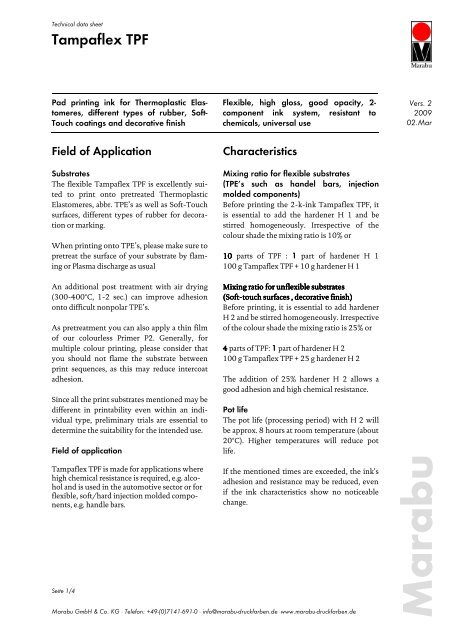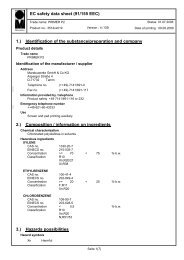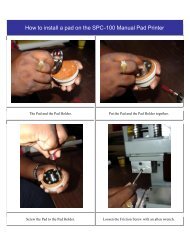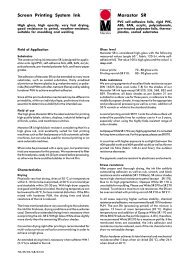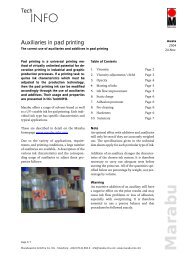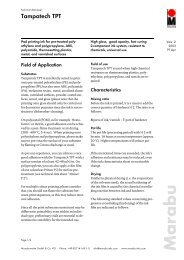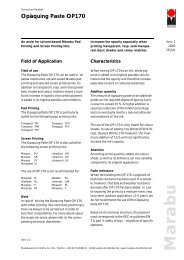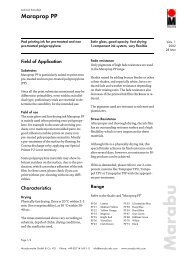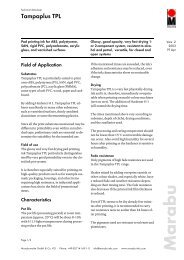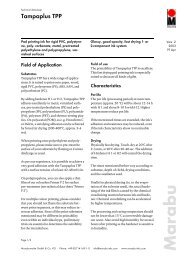Tampaflex TPF - American Pad Printing
Tampaflex TPF - American Pad Printing
Tampaflex TPF - American Pad Printing
Create successful ePaper yourself
Turn your PDF publications into a flip-book with our unique Google optimized e-Paper software.
Technical data sheet<br />
<strong>Tampaflex</strong> <strong>TPF</strong><br />
<strong>Pad</strong> printing ink for Thermoplastic Elastomeres,<br />
different types of rubber, Soft-<br />
Touch coatings and decorative finish<br />
Field of Application<br />
Substrates<br />
The flexible <strong>Tampaflex</strong> <strong>TPF</strong> is excellently suited<br />
to print onto pretreated Thermoplastic<br />
Elastomeres, abbr. TPE’s as well as Soft-Touch<br />
surfaces, different types of rubber for decoration<br />
or marking.<br />
When printing onto TPE’s, please make sure to<br />
pretreat the surface of your substrate by flaming<br />
or Plasma discharge as usual<br />
An additional post treatment with air drying<br />
(300-400°C, 1-2 sec.) can improve adhesion<br />
onto difficult nonpolar TPE’s.<br />
As pretreatment you can also apply a thin film<br />
of our colourless Primer P2. Generally, for<br />
multiple colour printing, please consider that<br />
you should not flame the substrate between<br />
print sequences, as this may reduce intercoat<br />
adhesion.<br />
Since all the print substrates mentioned may be<br />
different in printability even within an individual<br />
type, preliminary trials are essential to<br />
determine the suitability for the intended use.<br />
Field of application<br />
<strong>Tampaflex</strong> <strong>TPF</strong> is made for applications where<br />
high chemical resistance is required, e.g. alcohol<br />
and is used in the automotive sector or for<br />
flexible, soft/hard injection molded components,<br />
e.g. handle bars.<br />
Seite 1/4<br />
Flexible, high gloss, good opacity, 2component<br />
ink system, resistant to<br />
chemicals, universal use<br />
Characteristics<br />
Mixing ratio for flexible substrates<br />
(TPE’s such as handel bars, injection<br />
molded components)<br />
Before printing the 2-k-ink <strong>Tampaflex</strong> <strong>TPF</strong>, it<br />
is essential to add the hardener H 1 and be<br />
stirred homogeneously. Irrespective of the<br />
colour shade the mixing ratio is 10% or<br />
10 parts of <strong>TPF</strong> : 1 part of hardener H 1<br />
100 g <strong>Tampaflex</strong> <strong>TPF</strong> + 10 g hardener H 1<br />
Mixing Mixing ratio ratio ratio for for unflexible unflexible substrates<br />
substrates<br />
(Soft (Soft-touch (Soft ouch surfaces surfaces , , , decorative decorative finish finish) finish<br />
Before printing, it is essential to add hardener<br />
H 2 and be stirred homogeneously. Irrespective<br />
of the colour shade the mixing ratio is 25% or<br />
4 parts of <strong>TPF</strong>: 1 part of hardener H 2<br />
100 g <strong>Tampaflex</strong> <strong>TPF</strong> + 25 g hardener H 2<br />
The addition of 25% hardener H 2 allows a<br />
good adhesion and high chemical resistance.<br />
Pot life<br />
The pot life (processing period) with H 2 will<br />
be approx. 8 hours at room temperature (about<br />
20°C). Higher temperatures will reduce pot<br />
life.<br />
If the mentioned times are exceeded, the ink's<br />
adhesion and resistance may be reduced, even<br />
if the ink characteristics show no noticeable<br />
change.<br />
Marabu GmbH & Co. KG ⋅ Telefon: +49-(0)7141-691-0 ⋅ info@marabu-druckfarben.de ⋅www.marabu-druckfarben.de Marabu<br />
Vers. 2<br />
2009<br />
02.Mar
Technical data sheet<br />
<strong>Tampaflex</strong> <strong>TPF</strong><br />
Drying<br />
Parallel to physical drying (i. e. the evaporation<br />
of the solvents used), the actual hardening of<br />
the ink film is caused by the chemical crosslinking<br />
reaction between ink and hardener.<br />
The following standard values concerning progressive<br />
cross-linking (hardening) of the ink<br />
film can be estimated at:<br />
Drying times H 2 H 1<br />
touch-dry 20 °C 1-2 min 4 min<br />
stackable 60 °C 30 min 60 min<br />
final hardness 20 °C 3-5 days 7 days<br />
final hardness 150°C 30 min 30 min<br />
pot life 20 °C min. 6 h 8h<br />
Chemical cross-linking can be accelerated by<br />
higher temperatures. The times mentioned<br />
vary according to substrate, depth of cliché,<br />
drying conditions, and the auxiliaries used.<br />
For an overprint in fast printing speed, the first<br />
lacquer layer can be dried with hot-air (ca,<br />
200°c, 2-3 sec.)<br />
For multiple colour printing, we point out that<br />
the previous printed ink film should not be<br />
entirely cured before the consecutive ink film<br />
is printed on top of it. By drying at room temperature,<br />
the consecutive print should be carried<br />
out within 12 hours after the previous<br />
print.<br />
The processing and curing temperature should<br />
not be lower than 15°C as irreversible damage<br />
can occur. It’s important to avoid high humidity<br />
for several hours after printing as the hardener<br />
is sensitive to humidity.<br />
Fade resistance<br />
Only pigments of high fade resistance are used<br />
in the <strong>Tampaflex</strong> <strong>TPF</strong> range. The pigments<br />
used are resistant to solvents and plasticizers.<br />
Seite 2/4<br />
Stress resistance<br />
After proper and thorough drying, the ink film<br />
exhibits outstanding adhesion as well as rub,<br />
scratch, and block resistance and is resistant to<br />
a large number of chemical products, oils,<br />
greases, and solvents<br />
Clichés<br />
All commercially available clichés made of<br />
photopolymer material, thin steel, and chemically<br />
hardened steel (10 mm) can be used. We<br />
recommend a cliché depth of 20-28 µm.<br />
<strong>Printing</strong> pads<br />
As per our experience, all common printing<br />
pads consisting of materials cross-linked by<br />
condensation or addition can be used.<br />
<strong>Printing</strong> machines<br />
<strong>Tampaflex</strong> <strong>TPF</strong> is suitable for closed ink cup<br />
systems, as well as for open ink wells. Depending<br />
on type and usage of the machine, it is necessary<br />
to adjust type and amount of the thinner<br />
used accordingly.<br />
Range<br />
Basic shades<br />
Refer to colour chart ‘System Tampacolor’<br />
<strong>TPF</strong> 920 Lemon<br />
<strong>TPF</strong> 950 Violet*<br />
<strong>TPF</strong> 922 Light Yellow * <strong>TPF</strong> 952 Ultramarine Bl.*<br />
<strong>TPF</strong> 924 Medium Yell. <strong>TPF</strong> 954 Medium Blue<br />
<strong>TPF</strong> 926 Orange<br />
<strong>TPF</strong> 956 Brilliant Blue*<br />
<strong>TPF</strong> 930 Vermilion * <strong>TPF</strong> 960 Blue Green<br />
<strong>TPF</strong> 932 Scarlet Red <strong>TPF</strong> 962 Grass Green *<br />
<strong>TPF</strong> 934 Carmine Red <strong>TPF</strong> 970 White<br />
<strong>TPF</strong> 936 Magenta* <strong>TPF</strong> 980 Black<br />
<strong>TPF</strong> 940 Brown<br />
(*semi-transparent/transparent)<br />
All shades are intermixable. To maintain the<br />
special characteristics of this outstanding ink<br />
range, <strong>TPF</strong> should not be mixed with other ink<br />
types.<br />
Marabu GmbH & Co. KG ⋅ Telefon: +49-(0)7141- 691- 0 ⋅ info@marabu-druckfarben.de ⋅ www.marabu-druckfarben.de<br />
Marabu
Technical data sheet<br />
<strong>Tampaflex</strong> <strong>TPF</strong><br />
The basic shades according to System Tampacolor<br />
are all included in our Marabu-<br />
ColorFormulator being build the calculation<br />
basis for individual colour matching formulas.<br />
The basic shades are further the basis for colour<br />
matches according to the common Pantone®,<br />
HKS®, and RAL®. All formulas are stored in<br />
the Marabu-Color Manager 2 (MCM 2) software.<br />
Press-ready silver shade<br />
<strong>TPF</strong> 191 Silver<br />
Bronzes<br />
(to be mixed with Overprint Varnish <strong>TPF</strong> 910)<br />
S 181 Aluminium<br />
S 182 Rich Pale Gold<br />
S 183 Rich Gold<br />
S 184 Pale Gold<br />
S 186 Copper<br />
S 190 Aluminium, rub-resistant<br />
Due to their chemical structure, Pale Gold<br />
S 184 and Copper S 186 have a reduced processing<br />
time. Please generally prepare fresh mixtures<br />
only as they cannot be stored and must be<br />
processed within 4 h.<br />
Clears<br />
<strong>TPF</strong> 910 Overprint Varnish, can also be used as bronze<br />
binder<br />
The pigments used in the above mentioned<br />
standard shades, based on their chemical structure,<br />
correspond to the EEC regulations EN<br />
71/part 3, safety of toys - migration of specific<br />
elements. All colours are suited for printing<br />
onto toys.<br />
Seite 3/4<br />
Auxiliaries<br />
Hardener: H 2, fast hardener<br />
H1, flexible hardener<br />
Thinner: TPV 6<br />
(also for screen printing)<br />
PPTPV, fast thinner<br />
TPV 3, slow thinner<br />
Retarder: SV 1<br />
VP, Retarder Paste<br />
Matting Powder: MP, addition 2-4%<br />
Primer: P 2, for polypropylene<br />
Cleaner: UR 4<br />
<strong>Printing</strong> Modifier: ES, addition: max. 0,5%<br />
The hardener should be added to the ink briefly<br />
before printing in the correct ratio as mentioned<br />
before.<br />
To adjust printing viscosity, it is generally sufficient<br />
to add 25-30% of thinner TPV 6 to the<br />
ink. Thinner PPTPV can be used for fast printing,<br />
TPV 3 for slow printing requirements.<br />
By adding matting powder MP, the glossy effect<br />
of the ink is reduced to a silky or semi-matt<br />
finish. The addition of a low percentage of MP<br />
(in the case of 970 White, max. 2%) will not<br />
influence the resistances of the ink significantly<br />
but it will reduce its opacity.<br />
For the printing of very fine motives, retarder<br />
SV 1 or retarder paste VP may be added to the<br />
ink. An excessive addition may result in ink<br />
transfer problems.<br />
Attention<br />
For an ink mixture containing retarder, only<br />
thinner should be used for additional thinning<br />
during the print run.<br />
Marabu GmbH & Co. KG ⋅ Telefon: +49-(0)7141- 691- 0 ⋅ info@marabu-druckfarben.de ⋅ www.marabu-druckfarben.de<br />
Marabu
Technical data sheet<br />
<strong>Tampaflex</strong> <strong>TPF</strong><br />
<strong>Printing</strong> Modifier ES contains silicone. It can be<br />
used to rectify flow problems on critical substrates<br />
by adding up to 1% by weight to the ink.<br />
If an excessive amount of printing modifier is<br />
added, flow problems are increased and adhesion<br />
may be reduced, especially when overprinting.<br />
Cleaning<br />
To clean ink containers, clichés, and tools,<br />
please use our cleaner UR 4.<br />
Recommendation<br />
The ink should be stirred well before printing.<br />
To protect the ink in opened containers against<br />
excessive drying, it can be carefully covered<br />
with a layer of thinner which can then be later<br />
stirred into the ink prior to printing.<br />
Labelling<br />
For our ink type <strong>Tampaflex</strong> <strong>TPF</strong> and its additives<br />
and auxiliaries, there are current Material<br />
Safety Data Sheets according to EC-regulation<br />
1907/2009 informing in detail about all relevant<br />
safety data including labelling according to<br />
the present EEC regulations as to health and<br />
safety labelling requirements. Such data may<br />
also be derived from the respective label. The<br />
ink has a flash point > 54°C.<br />
Seite 4/4<br />
Note<br />
Please refer to the information in our technical<br />
data sheets of pad printing inks. Our technical<br />
advice whether spoken, written, or through<br />
test trials corresponds to our current knowledge<br />
to inform about our products and their<br />
use. This is not meant as an assurance for certain<br />
properties of the products nor their suitability<br />
for each application.<br />
You are, therefore, obliged to conduct your<br />
own tests with our supplied products to confirm<br />
their suitability for the desired process or<br />
purpose. The selection and testing of the ink<br />
for a concrete application are exclusively your<br />
responsibility.<br />
Should, however, any liability claims arise,<br />
they shall be limited to the value of the goods<br />
delivered by us and utilised by you with respect<br />
to any and all damages not caused intentionally<br />
or by gross negligence.<br />
Marabu GmbH & Co. KG ⋅ Telefon: +49-(0)7141- 691- 0 ⋅ info@marabu-druckfarben.de ⋅ www.marabu-druckfarben.de<br />
Marabu


